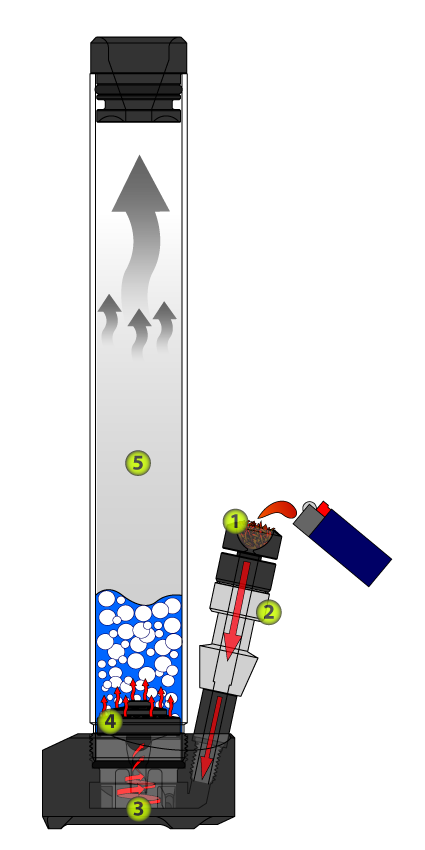
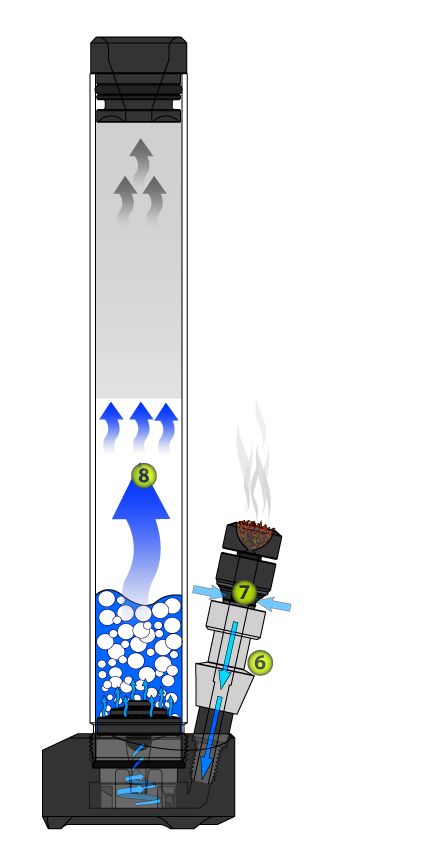


Smoking (combustion) Phase
1) Tobacco is combusted in bowl.
2) Smoke travels down the stem and enters the base of the waterpipe.
3) Smoke is injected into a high-velocity cyclone filter via 3 smoke nozzles. Suspended ash is removed from the air.
4) Smoke is then split up into hundreds of tiny bubbles which are further cooled and filtered by the water.
5) Smoke fills the empty void in the body of the water pipe, until desired smoke volume is obtained.
Purging Phase
6) User presses stem Bypass Valve
7) Air bypasses the bowl and is allowed to flow into the stem.
8) Incoming fresh air lifts the smoke column from the bottom until the pipe is cleared of smoke.


How it Works
Use the ![]() and
and ![]() arrows below to toggle between smoking and purging phases.
arrows below to toggle between smoking and purging phases.
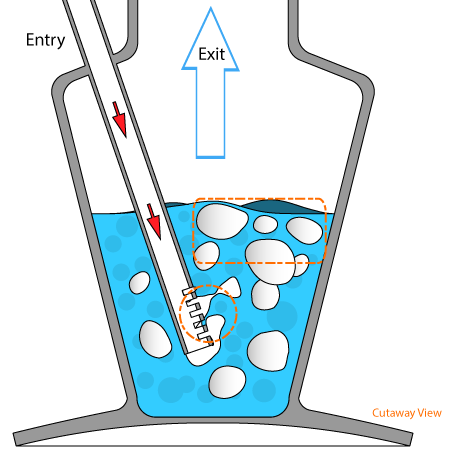
Localized Dispersion
Smoke bubbles produced by this waterpipes' diffuser (perc) do not spread evenly throughout the width of the water bath.
When the smoke bubbles prefer to rise on one side of the pipe rather than the other, they tend to rise to the surface quicker (due to formation of eddy-currents in the water), thereby reducing the time that the smoke is exposed to the water. Shorter exposure times can have a significant impact on filtration (smoothness) of the water pipe.
Size and Shape Variance
Bubbles have significantly varying size and shape, causing undependable filtration.
Bubble Amalgamation
During bubble formation via this type of percolator, the bubbles have a high tendency to combine (amalgamate) into larger bubbles due to the shape and orientation of the diffuser.
So in this 5-slit diffuser scenario, rather than emitting 5 bubbles as one might think, it instead produces 1-3 bubbles.
This amalgamation behavior means bigger smoke bubbles, which significantly reduces filtration.

The JET Difference
Return To Top![]()
Typical Waterpipe Diffuser
The usual percolator consists of a glass stem with rectangular slots to diffuse the smoke. A very simple design indeed, but contains the following drawbacks:
The JET Diffuser
Now lets take a look at the clog-free, filtration powerhouse within the JET Subzero Waterpipe:
Uniform Dispersion
Smoke bubbles are distributed evenly across the width of the water bath, ensuring maximum percolation!
This is made possible by the uniform spacing of the diffuser nozzles, and their axial orientation to the water bath, resulting in a smooth/consistent draw rather than a rough "bubbling" feeling.
Consistent Size and Shape
Bubbles are near spherical, and are very similar in size (diameter) from bubble to bubble. This ensures that each bubble of smoke gets a chance to interact with the water, resulting in an unquestionably soft, silky hit.
Retention-Barrel Technology
Our patented diffuser-nozzle geometry keeps bubbles from amalgamating into larger ones by isolating the bubble-formation phase between percolator nozzles.
This ensures that the bubbles remain as small and as separate as possible, which gives the user a ridiculously smooth hit one smoking session after another.
1) Formation Phase:Smoke is pulled into the Nozzle of the diffuser where the bubble begins to form. During formation the bubble is briefly held down due to the Low-Pressure Regions formed by the Nozzle-to-Barrel diameter transition. Once the bubble diameter expands to the width of the barrel, it forms enough buoyancy to break free of the Nozzle. 2) Retention Phase:Once broken free from the Nozzle, the smoke bubble travels up the Barrel where it is shortly held until another formation phase begins. The time that it takes this Formation-Retention cycle to occur depends on the Barrel height. So when two barrels of different heights are close to one another, they produce bubbles at different frequencies (# of bubbles per second) therefore preventing bubble amalgamation after the retention phase.This is one of the reasons our diffuser has a “stepped” shape! (notice how the center barrels are much deeper than the perimeter barrels) 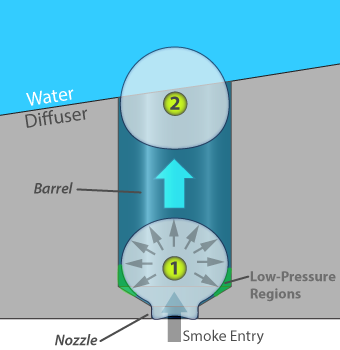 Minimal nozzle height prevents water pipe from clogging
Minimal nozzle height prevents water pipe from clogging
Bubble Surface Area
what's the big deal?
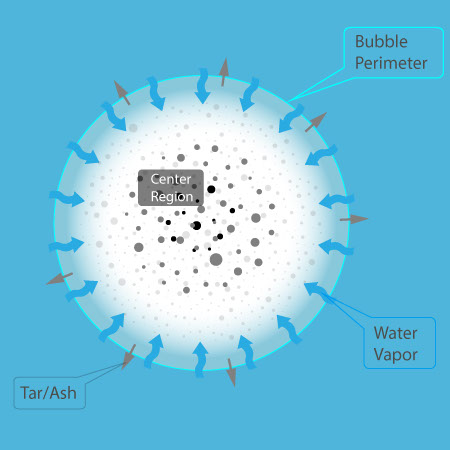
The illustration to the left shows the general anatomy of a bubble of smoke in a waterpipe. The smoke contains tar, ash and some non-combusted material (represented by the Grey/Black dots).
Once produced by the water pipe diffuser, the bubble begins to rise to the surface, during which a large portion of the filtration process occurs (when smoke is completely surrounded by water).
The tar, ash and non-combusted matter (contaminants) interact (shown by arrows) with the water in the following aspects:
Solid phase contaminants (ash and plant matter), become suspended in the water.
Liquid phase contaminants (tars), condense into tiny droplets and become suspended in the water.
Water Vapor evaporates into the air inside the bubble.
However these smoke/water interactions can only take place along the Smoke Bubble Perimeter (notice how the arrows must cross this boundary to “interact”). This Bubble Perimeter is quantified by the Surface Area.
This means that the contaminants in the bubble “Center Region” very rarely have a chance to interact with the water, and therefore remain unfiltered.
This means that overall Filtration (smoothness of hit) is heavily dependent upon the bubble Surface Area and the length of time that the bubble is exposed to the water.
Return To Top![]()
Bubble Division
the smaller the better
In the previous section, we learned that surface area plays a critical role in overall waterpipe filtration, so how can we increase it?
The answer is simple, the smoke needs to be split into many tinier bubbles, and heres why:
Consider the illustration to the right; in scenario-A we have one bubble of 0.5 inches in diameter which has a given volume and surface area.
Now, if we take that single large bubble and equally split its volume up into bubbles of 0.1 inches in diameter (1/5th diameter of original), then we would have 125 of those smaller bubbles (scenario-B).
When bubbles are divided like this, the result is an increased surface area, and in scenario-B the surface area has increased by a factor of 5! (in comparison to scenario-A)
Meaning that scenario-B would filter out almost 5 times more ash, tar and non-combusted matter than scenario A!
So why not just use a smaller tube or hole to create smaller bubbles?
This is the most obvious solution, which works very well with gases that are “clean”, but unfortunately we are dealing with smoke that contains tars, ash and unburned tobacco. So a smaller tube would work, but due to the sticky nature of the smoke and its constituents, would quickly condense/deposit, thereby clogging the pipe (and who would want to clean their waterpipe every day?)
Cyclone Technology
harnessing the power of centrifugal force
Return To Top![]()
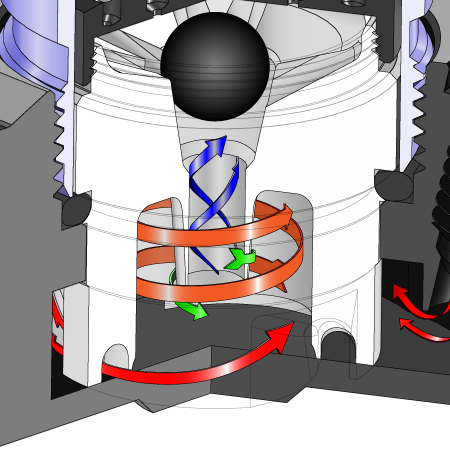
![]() Red Arrows:
Red Arrows:
Smoke enters the base cavity where it is redirected into the three precision machined nozzles of the cyclone filter. This accelerates the smoke to a higher velocity.
![]() Orange Arrow:
Orange Arrow:
The accelerated smoke enters the main cavity of the cyclone filter where it spirals up to the top, forming the outer low-speed cyclone.
This low-speed cyclone is where the larger debris is thrown out of the smoke-stream
![]() Green Arrow:
Green Arrow:
Smoke is now forced to the center of the main cavity where it forms the smaller, high speed cyclone.
This high-velocity cyclone separates out the smaller debris, such as dust-sized ash.
![]() Blue Arrows:
Blue Arrows:
The filtered smoke is now allowed to pass through the center channel of the core, where it will move through the check valve on to the water bath for further filtering.
In the very heart of the JET Subzero water pipe, exists a unique form of smoke filtration. Using centrifugal force, both large and small ash particles are thrown out of the smoke prior to being diffused through the water bath, resulting in an unbelievably smooth hit.
Valved Pipe Stem
Return To Top![]()
Here at JET, we decided to make it even more interesting by adding a spring loaded bypass valve to the stem. So now rather than pulling the bowl out to clear the pipe of smoke, all the user has to do is simply PUSH!
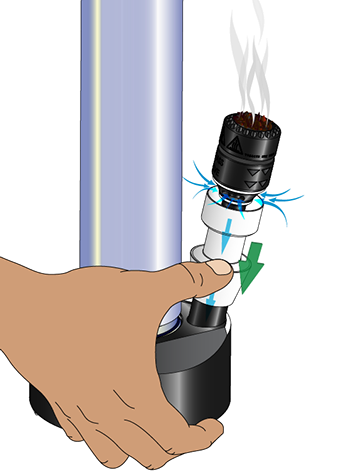
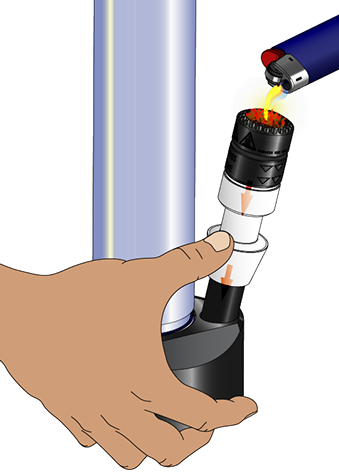 BurnPurgeWhen stem valve is in its resting position, smoke is allowed to pass from the bowl into the stem.Once the white sleeve is pressed down, clean cool is injected below the bowl, producing the same effect as removing the bowl.
BurnPurgeWhen stem valve is in its resting position, smoke is allowed to pass from the bowl into the stem.Once the white sleeve is pressed down, clean cool is injected below the bowl, producing the same effect as removing the bowl.
This water pipe produces an unexpectedly smooth hit. For a first time user, we recommend waiting a few minutes after the first hit, before taking a second.
You must be 18 years of age or older to visit this site. By entering and/or accessing this Site, you are representing and warranting that you are 18 years of age or older.
If you are under 18 years of age, click here to exit now.
The term “waterpipe” is in reference to a device constructed for the sole purpose of filtering tobacco smoke/vapor via one or multiple water baths. Usage of this site is subject to our terms and conditions
2018 JET Filtration Systems
©



